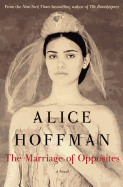
An innovator of Impressionism, Camille Pissarro is closely associated with France and the seminal artistic movement he helped inspire there. His start in life and in painting, though, happened a world away, on the Caribbean island of St. Thomas, where he studied "waves, sand, birds, light" and dreamed in shades of blue.
In The Marriage of Opposites, Alice Hoffman unfolds the intriguing story of Pissarro's beginnings. She adeptly and beautifully imagines the tempestuous life of the artist's mother, Rachel Pomié, who defied convention for passion, and how his formative years on the island influenced him personally and professionally.
Growing up on then Dutch-held St. Thomas in the early 1800s, Rachel refuses to follow the rules. Constantly at odds with her stern mother, a pillar in their community of refugee Jewish settlers who fled persecution, she longs for a life in Paris. But despite Rachel's intelligence and headstrong nature, her future is not her own to determine. In her early 20s, she is married off to Isaac Petit, an older widower with three children, saving her father's company with the union and derailing her hopes of leaving the island.
Instead Rachel is firmly tethered to St. Thomas, becoming the mother of six children and step-children and helping Isaac run his retail business. Then, six years after their marriage, her husband dies of a heart attack while she is pregnant. Women aren't legally allowed to own property, and the business passes to Isaac's relatives in France.
Hoffman begins The Marriage of Opposites by focusing on Rachel, a fascinatingly complex character who drives the narrative even when readers aren't hearing from her directly. The first time the story switches perspectives is with the arrival of Frédéric Pizzarro, Isaac's 22-year-old nephew, to oversee the business in St. Thomas. Fresh off a voyage from France, he is immediately smitten with the tropical island--and with Rachel.
The sultry St. Thomas that Hoffman describes is an exotic place with jasmine-scented air, gritty, bustling wharves, houses built on stilts and accented with brightly hued shutters, pink bougainvillea climbing stucco walls and parrots perched in tamarind trees. The Jewish population--called Creoles, Europeans who have never been in Europe--accounts for nearly half the island's inhabitants, who share the space with the native Caribs. But even on this "small speck of land" suspended in the sea, written and unwritten rules govern people's behavior.
When Rachel and Frédéric begin a love affair, it ignites a scandal that's further fueled when the local religious official refuses to marry them. Although both are Jewish, they're members of the same family and therefore forbidden to wed one another. Even a dispensation from religious higher-ups in the Netherlands recognizing them as married fails to earn them acceptance. Being ostracized by the Jewish community doesn't deter Rachel, and she remains resolute in her decision to be with Frédéric no matter the cost. "As a girl I'd done what was necessary, but I was a girl no longer," she says. This time she chooses her spouse.
The Pizzarro family's status as outcasts is good luck as far as Rachel and Frédéric's third son, Camille, is concerned, since it gives him greater freedom to roam the island sketching and making his own pigments from petals and other natural ingredients. "This was my library, the landscape around me, luminous and white-hot or starry and black." Even as a young boy, he is drawn to create his art en plein air, a hallmark of Impressionism.
Much of the second half of The Marriage of Opposites is told from Camille's point of view--his overwhelming desire to become an artist, his connections to people and places on the island and his complicated, contentious relationship with his mother. Rachel privately admits to loving him the best of all her children, acknowledging that he is the most like her and has her faults. Their strong personalities often leave the two at odds. Even though Rachel appreciates "the sheer beauty of her son's artistry," she wants him to take an easier, more conventional path and encourages him to join the family business.
Like Rachel, her son refuses to follow others' dictates. "Our eyes were the same. Dark and filled with defiance," says Camille, who inherited his mother's rebellious spirit and courage to be a nonconformist--qualities that drive him to become a key figure of Impressionism, an avant-garde movement that upset the established art world and initially garnered harsh criticism. Eventually Rachel must make a choice: try to tie Camille to St. Thomas or support him in his artistic pursuits... and, along the way, fulfill her own long-held dream of traveling beyond the island's shores. (In a further show of individuality, the artist later changed his surname to the French spelling Pissarro.)
Hoffman's fans and those of historical fiction in general will savor The Marriage of Opposites, a vividly rendered account of how one woman's refusal to deny true love ultimately helped lead to an artistic revolution. When Camille first realizes his talent, he feels as if he has "come upon the core of the meaning of life, to discover and re-create beauty." While he created with paint and brush, Hoffman's medium is words. The Marriage of Opposites is a story as sublime as an Impressionist painting. --Shannon McKenna Schmidt

